#authoring tool
Explore tagged Tumblr posts
Text
10 Non-Lethal Injuries to Add Pain to Your Writing
New Part: 10 Lethal Injury Ideas
If you need a simple way to make your characters feel pain, here are some ideas:
1. Sprained Ankle
A common injury that can severely limit mobility. This is useful because your characters will have to experience a mild struggle and adapt their plans to their new lack of mobiliy. Perfect to add tension to a chase scene.
2. Rib Contusion
A painful bruise on the ribs can make breathing difficult, helping you sneak in those ragged wheezes during a fight scene. Could also be used for something sport-related! It's impactful enough to leave a lingering pain but not enough to hinder their overall movement.
3. Concussions
This common brain injury can lead to confusion, dizziness, and mood swings, affecting a character’s judgment heavily. It can also cause mild amnesia.
I enjoy using concussions when you need another character to subtly take over the fight/scene, it's an easy way to switch POVs. You could also use it if you need a 'cute' recovery moment with A and B.
4. Fractured Finger
A broken finger can complicate tasks that require fine motor skills. This would be perfect for characters like artists, writers, etc. Or, a fighter who brushes it off as nothing till they try to throw a punch and are hit with pain.
5. Road Rash
Road rash is an abrasion caused by friction. Aka scraping skin. The raw, painful sting resulting from a fall can be a quick but effective way to add pain to your writing. Tip: it's great if you need a mild injury for a child.
6. Shoulder Dislocation
This injury can be excruciating and often leads to an inability to use one arm, forcing characters to confront their limitations while adding urgency to their situation. Good for torture scenes.
7. Deep Laceration
A deep laceration is a cut that requires stitches. As someone who got stitches as a kid, they really aren't that bad! A 2-3 inch wound (in length) provides just enough pain and blood to add that dramatic flair to your writing while not severely deterring your character.
This is also a great wound to look back on since it often scars. Note: the deeper and wider the cut the worse your character's condition. Don't give them a 5 inch deep gash and call that mild.
8. Burns
Whether from fire, chemicals, or hot surfaces, burns can cause intense suffering and lingering trauma. Like the previous injury, the lasting physical and emotional trauma of a burn is a great wound for characters to look back on.
If you want to explore writing burns, read here.
9. Pulled Muscle
This can create ongoing pain and restrict movement, offering a window to force your character to lean on another. Note: I personally use muscle related injuries when I want to focus more on the pain and sprains to focus on a lack of mobility.
10. Tendonitis
Inflammation of a tendon can cause chronic pain and limit a character's ability to perform tasks they usually take for granted. When exploring tendonitis make sure you research well as this can easily turn into a more severe injury.
This is a quick, brief list of ideas to provide writers inspiration. Since it is a shorter blog, I have not covered the injuries in detail. This is inspiration, not a thorough guide. Happy writing! :)
Looking For More Writing Tips And Tricks?
Check out the rest of Quillology with Haya; a blog dedicated to writing and publishing tips for authors!
Instagram Tiktok
#hayatheauthor#haya's book blog#haya blogs#writing community#quillology with haya#writing tools#writer things#writing advice#writer community#writing techniques#writing prompt#writing stuff#creative writing#ya writing advice#writing tips and tricks#writer tools#writers of tumblr#writer blog#writers block#quillology with haya sameer#writers on tumblr#writerscommunity#writer stuff#author help#author advice#author#writing inspiration#writeblr#novel writing#on writing
61K notes
·
View notes
Text
0 notes
Text
Character Building
Some things to think about when building/describing a character:

Physical traits
Hair: color and length. Maybe it's natural, maybe it's dyed
Build: height, weight, muscle
Face: maybe they have a longer nose or forehead. Think about specific features like freckles, gapped teeth, jaw shape, acne scars, lip shape
Eyes: eye color, shape,
Backstory
Where is your character from?
Do they have family? How has that affected their personality?
What are their goals?
What are their likes/dislikes?
Strengths and weaknesses
Age
Personality
Voice: is their voice deep? Lilted? Strained?
How do they react to stressful situations?
What do they wear?
Are they kind? Meaner? Restrained?
How do they move? If they're older maybe they're a bit slower. Maybe your character is clumsy or move awkwardly
Body language/face: is your character normally more serious? Do they have RBF? Maybe they smile more or their face is more relaxed at rest. Maybe they leave their hands on their hips a lot, or prefer them crossed or in their pockets.
How are they perceived by others? How do they view the people around them?
Should I dive deeper on some of these?
#creative writing#my writing#short story#snippet#story#writers on tumblr#writers community#writing#writeblr#writers and poets#prompt list#prose#writing prompt#words#character design#aspiring writer#aspiring author#writerscommunity#character description#writing tips#writing things#writing tool#writing advice#writing and poetry
3K notes
·
View notes
Text
Top 10 AI eLearning Authoring Tools for Engaging Courses
I. Introduction of AI eLearning Authoring Tools
In recent years, eLearning has become popular as a solid way to deliver instructional information and training across various industries. The broad use of eLearning solutions has been made possible by the digital revolution and the expanding accessibility of the internet and mobile devices. eLearning has become a flexible and successful education and skill development method, Whether it’s professional training, coaching, or workplace programs, we have the easiest solution for you. Let’s discover the list of AI eLearning authoring tools.
What are eLearning Authoring Tools?
eLearning authoring tools are software applications used to develop material for online learning and training. They allow for creating instructional materials in specific digital formats or eLearning standards like SCORM and HTML5. The information made with these authoring tools is often provided via a learning management system (LMS) or in an HTML 5 web browser.
A. Lets Discuss Desktop Authoring Tools and Cloud-Based Authoring Tools
Technically, eLearning authoring tools are divided into Desktop and cloud-based solutions. Each group has distinct qualities that impact the course development process. Let’s take a closer look at both types of authoring tools.
Desktop Tools
Desktop authoring tools have a long history and are famous for developing digital instructional content. They typically include more advanced features such as branching scenarios, vast customization possibilities, and simulated experiences. Nowadays, the best authoring tools on the market often comprise a core desktop application supplemented by a cloud-based online collaboration platform.
You can access the authoring tools for Desktop from multiple computers, but you may need to obtain various licenses. Users are responsible for keeping all their data on their local machines and should make regular backups to safeguard their training materials.
Cloud-based Applications
Cloud-based eLearning authoring tools enable content authors to access their projects via a web browser, allowing for real-time collaboration and smooth content changes. These programs frequently include a user-friendly ‘app style’ web interface and offer pre-made content templates and multimedia assets for creating lightweight content.
Using cloud-based eLearning creation tools requires an internet connection, but they provide greater content accessibility and flexibility. This feature is highly beneficial for collaborative corporate eLearning initiatives. It allows instructors and learners to share training courses while securely saving all data on the provider’s cloud-hosting platform.
B. The Role of eLearning Authoring Tools in Course Creation
At the heart of eLearning is the course creation process, where instructional content is developed and organized into engaging and interactive learning experiences. It is where eLearning authoring tools play a pivotal role. These software applications empower educators, instructional designers, and training specialists to craft compelling and dynamic eLearning courses. With the help of these tools, content creators can incorporate multimedia elements, interactive assessments, simulations, and various learning activities, enhancing the overall learning experience for learners.
Select Right Authoring Software with AI
Selecting the right eLearning authoring software is crucial to the success of any eLearning initiative. Each tool comes with its own unique set of features, capabilities, and limitations. A well-chosen authoring tool can streamline course creation, boost productivity, and offer seamless integration with learning management systems (LMS) for efficient course delivery and tracking.
On the other hand, a wrong choice may lead to frustration, inefficiency, and limitations in content creation. Therefore, it is essential to carefully evaluate and consider the specific needs and requirements of the intended eLearning projects before settling on an authoring software. With numerous options available in the market, understanding the critical criteria for evaluation, such as functionality, user-friendliness, customer support, pricing, and compatibility, will aid in making an informed decision.
In the following sections, we will explore the best ten eLearning authoring tools and software, highlighting their unique features and target audiences to assist you in finding the ideal tool that best aligns with your eLearning goals.
CogniSpark AI eLearning authoring tool:

Selecting the right eLearning authoring software is crucial to the success of any eLearning initiative. Each tool comes with its own unique set of features, capabilities, and limitations. A well-chosen authoring tool can streamline course creation, boost productivity, and offer seamless integration with learning management systems (LMS) for efficient course delivery and tracking.
On the other hand, a wrong choice may lead to frustration, inefficiency, and limitations in content creation. Therefore, it is essential to carefully evaluate and consider the specific needs and requirements of the intended eLearning projects before settling on an authoring software. With numerous options available in the market, understanding the critical criteria for evaluation, such as functionality, user-friendliness, customer support, pricing, and compatibility, will aid in making an informed decision.
In the following sections, we will explore the best ten eLearning authoring tools and software, highlighting their unique features and target audiences to assist you in finding the ideal tool that best aligns with your eLearning goals.
Get started for free now!
Click Here
Adobe Captivate:

Using the Adobe Captivate authoring tool, you may create mobile-friendly courses. Make compliance/soft skills courses, multi-module courses, and a variety of other courses. With only a few clicks, you can accelerate course creation and begin speedy training for your personnel. It offers ready-to-use slides that allow you to plug and play your content to create learning projects in minutes. To make learning more engaging and thrilling, transform PowerPoint lessons into interactive films. Create virtual reality walkthroughs and complete the courses adaptable with various device sizes.
Lectora:

Lectora offers Desktop and online authoring. It includes strong tools for a streamlined course authoring experience. It has an integrated library, interactive templates, virtual reality walkthroughs, and more. The eLearning authoring tool facilitates rapid course construction and has several learning modes for rapid modular course development. Create the courses and make learning adaptive and entertaining using the most powerful tools available.
Easygenerator:

This tool is useful for creating and designing courses, as well as collaborating and sharing them with others. It aids in the simplification and acceleration of learning growth. eLearning professionals to subject matter experts may use a single application to build courses, distribute interactive content, track results, and work with different writers. Using pre-made templates, you may create the ideal training. Collect data to track student performance, solicit input from learners, and plan for future improvements. The best eLearning authoring tool provides tailored help for your training programs.
Articulate Storyline 360:

Articulate Storyline 360 is one of the greatest eLearning authoring tools on the market. With Storyline, you can design slide-based lessons that combine instructions, audio, video, and engaging online courses. You can arrange your stuff on the slide by utilizing various elements. Some pre-built interactions and templates can make eLearning authoring quick and easy. You can personalize your content; the slides respond to screen size and quality changes.
Gomo:

Gomo is a collaborative eLearning authoring tool for creating visually appealing interactive courses. It offers advanced functionality and is completely customizable, making it a designer’s favorite. You may create compelling and interactive information about your brand and train your staff fast and effortlessly. Because Gomo is cloud-based, you can access it from any browser and design, evaluate, and share course content. It is multi-language compatible and works with all types of businesses.
Ispring Suite:
The iSpring Suite is a PowerPoint-based authoring toolkit that enables users to learn through slide-based courses. It will allow you to design eLearning content for recruit onboarding, soft skills development, product training, and assessment, among other things. With only a few clicks, you can train your salespeople and employees. Convert PowerPoint slides while retaining animation effects, transitions, and other features to keep training content and quality. Set up video lectures, record sessions and tutorials, and use visual and video content to motivate learners.
H5P:
H5P is an open-source authoring tool that allows users to create interactive educational exercises accessed through a browser. You may create interactive films, course presentations, crossword puzzles, matching memory games, and more. There are over forty different types of interactive learning activities to choose from.
There are three ways in which H5P can be utilized. The first is with WordPress, Drupal, and Moodle plug-ins. It will be free eLearning creation software in this situation. Other options include using a direct link and adding the activities to any platforms, blogs, or other sites, enabling embedded content or distributing the content to learning management systems like Canvas, Brightspace, Blackboard, Moodle, and others implementing the LTI standard. H5P.com provides the latter services and needs a paid subscription.
Camtasia:

H5P is an open-source authoring tool that allows users to create interactive educational exercises accessed through a browser. You may create interactive films, course presentations, crossword puzzles, matching memory games, and more. There are over forty different types of interactive learning activities to choose from.
There are three ways in which H5P can be utilized. The first is with WordPress, Drupal, and Moodle plug-ins. It will be free eLearning creation software in this situation. Other options include using a direct link and adding the activities to any platforms, blogs, or other sites, enabling embedded content or distributing the content to learning management systems like Canvas, Brightspace, Blackboard, Moodle, and others implementing the LTI standard. H5P.com provides the latter services and needs a paid subscription.
Elucidat:

Elucidat is a cloud-based authoring tool for creating responsive and SCORM-compliant eLearning content. It allows team collaboration and offers templates, resources, and mobile-responsive editing. Elucidat is a platform that creates high-quality eLearning, provides online training resources, and monitors performance – all in one convenient package. The platform consists of buttons, input boxes, and traditional elements.
Conclusion:
It is evident that technology has its benefits and drawbacks when it comes to education. While it can undoubtedly enhance the learning process and grant access to a plethora of resources, it can also be a source of distraction and hinder face-to-face interaction. As educators and learners, we must strike a balance and use technology responsibly and effectively. Only then can we unleash its full potential and improve the quality of education, ultimately preparing students for the future.
0 notes
Text
Okay writers listen up
I'm gonna tell you about how I wrangled my shitbird brain into being a terrifying word-churning engine and have written over 170K words in under a year.
I wanna be clear that before unlocking this Secret Technique I was a victim of my unmedicated ADHD, able to start but never finish, able to ideate but not commit and I truly and firmly believed that I'd never write a novel and such a thing was simply outside of my reach.
Now I write (and read!!) every day. Every. Single. Day. Like some kind of scriptorial One Punch Man.
Step the First
Remove friction between yourself and writing.
I personally figured out how to comfortably write on my phone which meant I didn't have to struggle with the insurmountable task of opening my laptop.
I don't care if this means you write in a Discord server you set up for yourself, but fucking do it. Literally whatever makes you write!
(if you do write somewhere that isn't a word processor PLEASE back your work up regularly!)
Step the Second
Make that shit a habit. Write every day.
For me, I allow myself the grace that ANY progress on writing counts. One sentence? Legal. Five thousand furious hyperfixated words? Also legal.
Every day, make progress. Any progress.
I deleted Twitter from my phone and did my best to replace doomscrolling with writing. If I caught myself idly scrolling I'd close whatever I was looking at and open my draft and write one (1) sentence until I made THAT a habit, too.
Step Two-point-Five
DO NOT REWRITE. If you are creating a first draft, don't back up or restart. Continous forward motion. Second drafts and editors exist. Firsts are for ripping the fucking thing out of your brain.
If you're working on revisions after an editor or beta readers or whoever has given you feedback, then you can rewrite that's OK (and it counts as your writing for the day!)
Step the Third
Now that you've found a comfortable way to write and are doing it every day, don't stop. Keep doing it. Remember, just one sentence is all you need. You can always do more, but if one lousy sentence is all you can manage then you're still successfully writing.
Remember: this is what worked for me. Try things until you find what works for you.
You can do it. I believe in you.
#am writing#writing resources#original writing#Writer#writeblr#author#Author resources#writing tools#writing#writing tool#long post#text post
5K notes
·
View notes
Text
A quick reminder that fanfics shouldn't be reposted anywhere ever unless you have the express permission of the author.
You want to translate a fic? Awesome, ask!
You want to make a podfic? Amazing, ask!
But it's disrespectful to an author to take their content and repost without telling them, EVEN if you did transformative work on it.
Yes, fanfics are free, and on ao3 they are even downloadable, but they are downloadable for private use! For you to have on your kindle and read in whatever format best suits you. Not to be REPOSTED on another site!
Please, please, if you want authors to continue posting stories publically you have to respect an author's desire to maintain some level of ownership over their work.
#fanfic#ao3#this is about lore.fm and the amount of readers I've seen not understanding the issue!#Coming from somebody who has terrible sight and often relies on text to speech#The issue isn't the text to speech tool it's the scraping ao3 and reposting author's work without consent part
1K notes
·
View notes
Text
Master Dialogue Writing Techniques for Engaging Fiction (For Writers)
(Beware, long post!)
As fiction writers, we all know that effective dialogue is essential for bringing our stories and characters to life. After all, the way our protagonists, antagonists, and supporting players speak to one another is one of the primary ways readers get to know them on a deep, intimate level. Dialogue reveals personality, uncovers motivation, and propels the narrative forward in a way that felt narration simply can't match.
But nailing natural, compelling dialogue is easier said than done. It's a craft that takes serious skill to master, requiring writers to have a keen ear for authentic speech patterns, a nimble handle on subtext and implication, and the ability to strike that delicate balance between being true to real-world conversation while also keeping things snappy, dynamic, and laser-focused on the story at hand.
If you're someone who struggles with crafting dialogue that truly sings, never fear. In this in-depth guide, I'm going to dive deep into the techniques and best practices that will help you elevate your dialogue writing to new heights. By the end, you'll have a toolbox full of strategies to ensure that every exchange between your characters is as gripping, revealing, and unforgettable as possible.
The Fundamentals of Effective Dialogue
Before we get into the more advanced nuances of dialogue writing, let's start by covering some of the foundational principles that all great fictional conversations are built upon:
Reveal Character One of the primary functions of dialogue is to give readers a window into who your characters are as people. The way they speak — their word choices, their tone, their body language, their turns of phrase — should provide vivid insight into their personalities, backgrounds, values, quirks, and emotional states.
Think about how much you can glean about someone just from how they communicate in real life. Do they use a lot of slang and shorthand? Are they verbose and flowery with their language? Do they struggle to make eye contact or fail to respond directly to questions? All of these subtle linguistic cues are powerful tools for crafting multi-dimensional characters.
Drive the Plot Forward While revelations about character are crucial, you also want to ensure that your dialogue is constantly pushing the story itself forward. Each exchange should feel purposeful, moving the narrative along by introducing new information, triggering plot points, creating conflict, or prompting characters to make pivotal decisions.
Dialogue that feels aimless or extraneous will ultimately bore readers and detract from the forward momentum of your story. Every line should have a clear intent or function, whether it's uncovering a hidden truth, setting up a future complication, or escalating the tension in a high-stakes moment.
Establish Distinct Voices In a story featuring multiple characters, it's crucial that each person has a clearly defined and differentiated way of speaking. Readers should be able to tell who's talking just from the rhythm, diction, and personality of the dialogue, without any additional context clues.
This doesn't mean every character has to have an over-the-top, hyper-stylized way of communicating. In fact, the most effective character voices often feel grounded and natural. But there should still be distinct markers — whether it's word choice, sentence structure, tone, or speech patterns — that make each person's voice instantly recognizable.
Convey Subtext While the literal words being spoken are important, great dialogue also traffics heavily in subtext — the unspoken emotional undercurrents, power dynamics, and hidden agendas that simmer beneath the surface of a conversation.
The most compelling exchanges happen when characters are communicating on multiple levels simultaneously. Perhaps they're saying one thing out loud while their body language and tone convey a completely different sentiment. Or maybe they're engaged in a subtle war of wits, trading verbal jabs that reveal deeper wells of resentment, attraction, or vulnerability.
Mastering the art of subtext is key to creating dialogue that feels layered, lifelike, and imbued with dramatic tension.
Strategies for Writing Snappy, Realistic Dialogue
Now that we've covered the foundational principles, let's dive into some specific techniques and best practices that will take your dialogue writing to the next level:
Omit Unnecessary Details One of the biggest mistakes many writers make with dialogue is bogging it down with too much extraneous information. In real life, people rarely speak in perfectly composed, grammatically correct full sentences. We stumble over our words, interrupt each other, trail off mid-thought, and pack our speech with filler words like "um," "uh," and "you know."
While you don't want to go overboard with mimicking that messiness, you should aim to strip your dialogue of any overly formal or expository language. Stick to the essentials — the core thoughts, feelings, and information being exchanged — and let the subtext and character voices do the heavy lifting. Your readers will fill in the gaps and appreciate the authenticity.
Master the Art of Subtext As mentioned earlier, crafting dialogue that's rich in subtext is one of the keys to making it feel gripping and lifelike. Think about how much is often left unsaid in real-world conversations, with people dancing around sensitive topics, conveying hidden agendas, or engaging in subtle power struggles.
To layer that sense of unspoken tension into your own dialogue, consider techniques like:
• Having characters contradict themselves or say one thing while their body language says another
• Utilizing loaded pauses, interruptions, and moments of uncomfortable silence
• Injecting subtle sarcasm, skepticism, or implication into a character's word choices
• Allowing characters to talk past each other, missing the unspoken point of what the other person is really saying
The more you can imbue your dialogue with that layered, emotionally-charged subtext, the more it will resonate with readers on a deeper level.
Establish Distinct Voices As mentioned earlier, ensuring that each of your characters has a clearly defined and differentiated speaking voice is crucial for great dialogue. But how exactly do you go about accomplishing that?
One effective strategy is to give each person a unique set of verbal tics, idioms, or speech patterns. Maybe one character is prone to long-winded, flowery metaphors, while another speaks in clipped, efficiency-minded sentences. Perhaps your protagonist has a habit of ending statements with questioning upticks, while the sarcastic best friend always punctuates their barbs with an eye roll.
You can also play with differences in diction, syntax, and even accent/dialect to further distinguish how your characters communicate. The key is to really get to know the unique personality, background, and psychology of each person — then let those elements shine through in how they express themselves.
Lean Into Conflict and Confrontation When it comes to crafting gripping dialogue, conflict is your friend. The most compelling exchanges often arise from characters butting heads, engaging in verbal sparring matches, or working through deep-seated tensions and disagreements.
Conflict allows you to showcase the high stakes, unresolved needs, and deeper emotional currents that are driving your characters. It forces them to make bold choices, reveals aspects of their personalities that might not otherwise surface, and generates the kind of dramatic tension that will really hook your readers.
Of course, you'll want to avoid making every single dialogue scene a full-blown argument. But learning to sprinkle in well-placed moments of friction, confrontation, and clashing agendas is a surefire way to elevate the energy and impact of your character interactions.
Read Your Dialogue Out Loud One of the most valuable tricks for ensuring your dialogue sounds natural and lifelike is to read it aloud as you're writing. Hearing the words out loud will quickly expose any clunky phrasing, overly formal grammar, or inauthentic rhythms that would otherwise go unnoticed on the page.
Pay close attention to how the dialogue rolls off your tongue. Does it have a smooth, conversational flow? Or does it feel stilted and unnatural? Are your characters' unique voices shining through clearly? Are there any spots where the back-and-forth starts to drag or feel repetitive?
Actively listening to your dialogue — and making adjustments based on how it sounds in the real world — is an essential part of the writing process. It's one of the best ways to refine and polish those character interactions until they feel truly alive.
Hopefully, this can help you all!
The key is to always keep your focus on authenticity. Ask yourself: how would real people actually speak?
Hey fellow writers! I'm super excited to share that I've just launched a Tumblr community. I'm inviting all of you to join my community. All you have to do is fill out this Google form, and I'll personally send you an invitation to join the Write Right Society on Tumblr! Can't wait to see your posts!

#writing#thewriteadviceforwriters#writeblr#creative writing#writing tips#on writing#writers block#how to write#writers and poets#writers on tumblr#authoradvice#author#fiction#indie author#writer#publishing#book writing#book quote#bookblr#books#writing advice#fiction writing#writing blog#writing tools#writing resources#novel writing#writer community#fantasy novel#readers#reading
883 notes
·
View notes
Text
Need a Number?
I don't know if this will actually help anyone, but if you have a hard time coming up with numbers in your writing (like an ID, a SSN, etc.), you might like this.
I literally just pick a word and then travel up my keyboard to the left.

So, like, in The Intelligence Control and Analysis Program, a Criminal Minds AU where geniuses are used as government resources (among other things), I needed IDs for them. So...
SPENCER-REID = 2036334-4383
Later on, I introduced Penelope, and...
PENNYGA-RCIA = 0366651-4381
And it just so happened the first three digits of each suffix were really similar, and that actually led to a whole aspect of the conspiracies around the government agency because something was off with the 4380s geniuses, and they wanted to know why.
But yeah. Most of you probably already do this, but I find it very helpful, and no one ever taught it to me, so I thought maybe it wasn't as widespread as I thought?
(Shifting is also great for making passwords, btw)
Enjoy your not-so-randomized numbers!
#writing tips#writing#author#writing resources#writing advice#writing help#writing tools#i don't know#maybe this will help#writers life#writers on tumblr#writer#write#ao3 writer#writeblr#writers and poets#writers#indie author#indie authors#indie writer#fanfic#fanfiction#fanfic writing#book writing#story writing#fiction writing#original fiction#writing a book#writing stuff#creative writing
381 notes
·
View notes
Text
5 Days of Helping You Outline Your Next Novel

Day 1: Benefits of Outlining Before Writing Your Book
Follow along for all 5 installments of the mini series: helping you outline your next novel

I. Clear Direction - knowing where you’re going allows you to pack the right kind of clothes, same with a novel - know where you’re going so you can bring the right stuff
II. Strong Structure - by writing an outline, you can structure your book to have a natural rise and a fall, like breathing
III. Consistency in Writing - not getting stuck with what happens next allows you to write more content more consistently
IV. Intentional Themes - by defining your story outline, you can sprinkle in some intentional symbols and themes within your writing
V. Better Character Development - knowing the overall arc of your story allows your characters to experience the moment and become who they’re meant to be. you can add in vulnerable moments, mistakes, and bad decisions to help them become the best (or worst) version of themselves
VII. Opportunities for Foreshadowing - by knowing where you’re going, you can add in witty little details of foreshadowing (ex: the mercenary had a reputation that - well, you’ll see) to string your readers along
VIII. Scene Variety - similar to pacing, scene variety can be inserted into your novel to prevent boring repetitions and keep the pov fresh and interesting
IX. Realistic Plot Lines - knowing the journey and destination before the characters do allows you to insert realistic motive and plot lines that drive your characters, instead of allowing your characters to drive the plot with unforeseen chaos (although this happens sometimes too and it’s okay!)

your reblogs help me help more ppl 💕
You can find Day 2 of this mini series [here].
follow along for writing prompts, vocabulary lists, and helpful content like this! <333
✨ #blissfullyunawaresoriginals ✨
#writeblr#writers on tumblr#creative writing#writerscommunity#fiction#character development#writing prompt#dialogue prompt#female writers#writer blog#outline#outlining#novel writing#fantasy novel#my novel#novelist#writing inspiration#fiction writing#fiction writer#indie author#ao3 writer#writing life#writers#writer#writing#writblr#writer stuff#writing tool#blissfullyunawares#blissfullyunawaresoriginals
160 notes
·
View notes
Text
Just found out that everything I have ever written has been AI scraped, despite me having my works on AO3 archive locked since early 2023, and I am so fucking angry, upset and disheartened.
At this point, I am not really sure if I want to continue writing (or at least publishing what I write) - I was beginning to feel deflated anyway, as giving support and motivation to others. and not feeling as though I get much back myself was killing my spark for fandom a little. Finding this out has killed it stone dead.
#despite the original site that hosted these having taken them down#the person behind this is still uploading the data set elsewhere#and due to the nature of fan fiction there is very little that authors can do legally#so filing a DMCA takedown isn't an option#I don't want to write just to have it used to fuel tools for people too lazy to do it themselves#I pour a little piece of myself into everything I write#this just feels so violating
109 notes
·
View notes
Text
★ 130 // “Everything's Fine! :D”
#jjba#jojo's bizarre adventure#steel ball run#sbr#johnny joestar#offerings#tools used:#ibis paint#vaporgram#// author's note: everything was in fact not fine#I got way too much happening in my life rn so sometimes ya just gotta vent it out. u_u#This was my first time using Ibis Paint and I can understand the hype for it as a mobile app#eyestrain /
55 notes
·
View notes
Text
100 Dialogue Tags You Can Use Instead of “Said”
For the writers struggling to rid themselves of the classic ‘said’. Some are repeated in different categories since they fit multiple ones (but those are counted once so it adds up to 100 new words).
1. Neutral Tags
Straightforward and unobtrusive dialogue tags:
Added, Replied, Stated, Remarked, Responded, Observed, Acknowledged, Commented, Noted, Voiced, Expressed, Shared, Answered, Mentioned, Declared.
2. Questioning Tags
Curious, interrogative dialogue tags:
Asked, Queried, Wondered, Probed, Inquired, Requested, Pondered, Demanded, Challenged, Interjected, Investigated, Countered, Snapped, Pleaded, Insisted.
3. Emotive Tags
Emotional dialogue tags:
Exclaimed, Shouted, Sobbed, Whispered, Cried, Hissed, Gasped, Laughed, Screamed, Stammered, Wailed, Murmured, Snarled, Choked, Barked.
4. Descriptive Tags
Insightful, tonal dialogue tags:
Muttered, Mumbled, Yelled, Uttered, Roared, Bellowed, Drawled, Spoke, Shrieked, Boomed, Snapped, Groaned, Rasped, Purred, Croaked.
5. Action-Oriented Tags
Movement-based dialogue tags:
Announced, Admitted, Interrupted, Joked, Suggested, Offered, Explained, Repeated, Advised, Warned, Agreed, Confirmed, Ordered, Reassured, Stated.
6. Conflict Tags
Argumentative, defiant dialogue tags:
Argued, Snapped, Retorted, Rebuked, Disputed, Objected, Contested, Barked, Protested, Countered, Growled, Scoffed, Sneered, Challenged, Huffed.
7. Agreement Tags
Understanding, compliant dialogue tags:
Agreed, Assented, Nodded, Confirmed, Replied, Conceded, Acknowledged, Accepted, Affirmed, Yielded, Supported, Echoed, Consented, Promised, Concurred.
8. Disagreement Tags
Resistant, defiant dialogue tags:
Denied, Disagreed, Refused, Argued, Contradicted, Insisted, Protested, Objected, Rejected, Declined, Countered, Challenged, Snubbed, Dismissed, Rebuked.
9. Confused Tags
Hesitant, uncertain dialogue tags:
Stammered, Hesitated, Fumbled, Babbled, Mumbled, Faltered, Stumbled, Wondered, Pondered, Stuttered, Blurted, Doubted, Confessed, Vacillated.
10. Surprise Tags
Shock-inducing dialogue tags:
Gasped, Stunned, Exclaimed, Blurted, Wondered, Staggered, Marvelled, Breathed, Recoiled, Jumped, Yelped, Shrieked, Stammered.
Note: everyone is entitled to their own opinion. No I am NOT telling people to abandon said and use these. Yes I understand that said is often good enough, but sometimes you WANT to draw attention to how the character is speaking. If you think adding an action/movement to your dialogue is 'good enough' hate to break it to you but that ruins immersion much more than a casual 'mumbled'. And for the last time: this is just a resource list, CALM DOWN. Hope that covers all the annoyingly redundant replies :)
Looking For More Writing Tips And Tricks?
Check out the rest of Quillology with Haya; a blog dedicated to writing and publishing tips for authors!
Instagram Tiktok
#hayatheauthor#haya's book blog#haya blogs#writing community#quillology with haya#writing tools#writer things#writing advice#writer community#writing techniques#writing prompt#writing stuff#creative writing#ya writing advice#writing tips and tricks#writer tools#writers of tumblr#writer blog#writers block#quillology with haya sameer#writers on tumblr#writerscommunity#writer stuff#author help#author advice#author#writing inspiration#writeblr#novel writing#on writing
30K notes
·
View notes
Text
SCORM vs AICC: Choosing the Right Standard for Your LMS

0 notes
Note
Hi! Could I ask for some body language for general love? Like fluffy kind of love? Shy but like.. I don’t know, flustered? A little hard to describe what I mean haha
Hi Anon! I had a lot of fun with this one
Writing Fluffy/Shy Love

Body language:
Prolonged or fleeting eye contact, dilated pupils, lingering gazes at the person your character(s) interested in. As if they’re fixated on something about this person, or looking for something new about them to fixate on. (If flustered, then darting their eyes away or quickly averting their gaze if caught staring)
Fidgeting, sweaty palms, leaning in
Closeness: your characters will find any excuse to touch. Holding hands, sitting close to one another, touching knees when seated, draping arms around shoulders or legs across laps, gentle touches, playful nudges, etc. This type of physical contact is gonna be a slow burn with flustered/shy characters. For example, if they're holding hands, don't just say they are, describe them inching closer, brushing one of their fingers against the other’s palm, making eye contact. Find nonverbal cues/body language that initiates closeness.
Soft smiles, relaxed brows, attentive looks (watching the other’s hands, eyes, lips, etc)
Frequent laughter, open posture
Subconsciously mirroring the other’s body language/picking up some of each other’s mannerisms or habits without realizing it
Inner thoughts or Dialogue:
Overthinking/over-analyzing interactions between them and the one they love
Deeper concern and empathy for the person they love
More genuine interest in what the other says/does, deeper understanding/knowledge of their habits and behavior. Maybe a character loads more attention on their partner’s words/wants above their own.
Dialogue/dynamics in a couple depends on their personalities. Can be more playful/teasing with banter, passionate, casual, quiet, etc. All relationships are different from more passionate ones to companionate ones, and more.
Are both character’s flustered? Explore what it looks like when they're both hesitant or shy around each other.
If it's one flustered character, what happens when the other notices how shy they are?
General tips:
Linger more on the simplicity/normalcy of the moment. Fluff isn't dramatic twists or arguments. Cuddling while watching a movie, character A playing with character B’s hair while they do the dishes, one doting on the other when they're sick.
The tone here is going to be more cute, domestic, and comfortable.
Remember that in fluffy/shy love it's a great start to have a friendship between the characters as a foundation rather than a romance standing on its own. Why do your characters love each other? What little things do they love about each other?
should i do dialogue prompts with this or try a post diving deeper on relationship dynamics?
#writersbloxx#writers on tumblr#creative writing#writers community#writing#writers and poets#my writing#writeblr#writers block#writers blog#writers#writing tool#writing tips#aspiring author
187 notes
·
View notes
Text
Steps to Writing an Enemies-to-Friends Relationship (No Romance or Sensual Tension)

follow for more tips 💋 || request writing tips 💌
1. Establish the Foundation
Define the Conflict: Clarify why these characters are enemies. Is it ideology, personal betrayal, competition, prejudice, or circumstance? The conflict should feel justified on both ends. Set Clear Boundaries: From the beginning, eliminate any hints of romantic tension. No suggestive dialogue, no lingering glances, no "will-they-won't-they" teases. Give Them Equal Strengths: Avoid power imbalances that suggest dominance or attraction. Their friction should stem from their beliefs, goals, or past—not unspoken desire.
2. Shape Their Role in the Story
Decide Their Narrative Purpose: Will they have to work together against a common enemy? Do they grow from rivalry to mutual respect? Determine how their evolving dynamic impacts the plot. Avoid Romantic Substitutes: Don’t use tropes like “angry confessions that turn into vulnerability” unless it’s clearly platonic. Let their growth come from empathy, not emotional seduction. Let Their Bond Matter: Their friendship should hold weight in the narrative. Make it feel just as powerful as romantic ones—without relying on attraction.
3. Build Their Dynamic
Use Natural Conflict-Resolution: Let them argue, clash, and call each other out. Gradually, introduce grudging respect and understanding. Highlight Differences and Growth: Show how their perspectives shift over time. Let their values clash, then overlap, then align. Allow Emotional Honesty (Platonically): Let them share personal experiences or open up over time.
4. Define Their Chemistry
Make Their Interactions Unique: Their banter, teamwork, or verbal spars should be distinctly non-romantic — more like frenemies turned allies or siblings who used to fight. Focus on Respect Over Intimacy: They may not like each other at first, but they come to respect each other’s strength, skill, or heart. Use Physical Space Wisely: Keep physical contact platonic or avoid it altogether. A handshake, a nod, a slap on the back — nothing coded with longing.
5. Demonstrate Their Impact on Each Other
Let Them Grow Together: Show how they push each other to improve. Maybe one learns humility, the other compassion. Create High-Stakes Collaboration: Put them in situations where they have to trust each other. Show how tension gives way to reliability. Allow Disagreements Without Regression: They can argue again even after becoming friends — just without regressing into hatred or falling into flirtation.
6. Develop a Satisfying Arc
Decide Their Long-Term Dynamic: Will they become close friends, uneasy allies, or respectful rivals? Make sure the conclusion fits their journey. Showcase Their Changed Perspective: Their friendship should feel earned. Use flashbacks or contrasts to show how far they’ve come. Avoid Subtext: Don’t write in lingering glances, “maybe if things were different” lines, or vague emotional ambiguity. Platonic means platonic.
Examples of Strong Enemies-to-Friends Relationships
Film/TV Examples:
Zuko & Aang (Avatar: The Last Airbender): From hunted enemies to one of the most supportive friendships in animation.
Magneto & Professor X (X-Men): Ideological enemies who respect each other deeply, even when at odds.
Shrek & Donkey (Shrek): Donkey annoys Shrek into eventual friendship—zero romance, just stubborn growth.
Literature Examples:
Brutus & Cassius (Julius Caesar): Complicated enemies-turned-collaborators, bound by politics, not love.
Nikki Maxwell and MacKenzie Hollister (Dork Diaries): Originally disdainful of each other, they become friends through shared enemies and interests.
Claire Warden & Butch Betcher (The Guardians of Camoria series): Once bitter enemies due to opposing beliefs and temperaments, their mutual goals and personal growth foster a tough-but-loyal alliance rooted in shared trauma and witty banter, not romance.

Follow || Like || Comment || Repost || My Novel ⇚⇚⇚


thank you, i am farkle :)
thank you @stardustcasti for the request :)
#౨ৎ a.a.walker's tips ౨ৎ#writer#writers on tumblr#creative writing#booklr#academia#aspiring author#nostalgia#artists on tumblr#on writing#college#on writers#writing tips and tricks#writing help#writing advice#writing resources#writing tips#how to write#writing stuff#fiction writing#writing community#writers life#writblr#writers of tumblr#writing tools#storytelling#narrative#publishing#fiction#author
69 notes
·
View notes
Note
May I ask the software you use to write?
Congratulations on getting so much done!
Thank you so much. And, of course.
I use the Reedsy Book Editor for all of my writing projects, and I've been using it for about three years now. I also have experience with other amazing softwares, and I would love to create more tutorials on them if you need me to.
Here's a quick tutorial on how to use the Reedsy Book Editor.
When you visit the website, the first thing you'll come across is this page. It's a completely free writing tool with a fantastic interface. All you need to do is sign up with your Google or Facebook account.
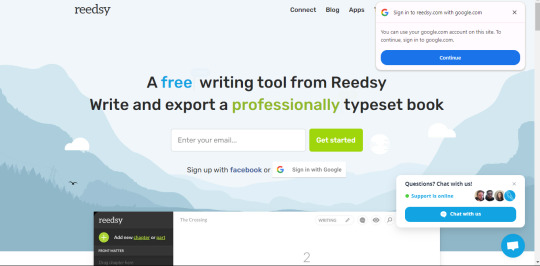
After you've completed the sign-up process and provided some information about yourself, you will be directed to this page. Please locate the "Books" option in the website's header.
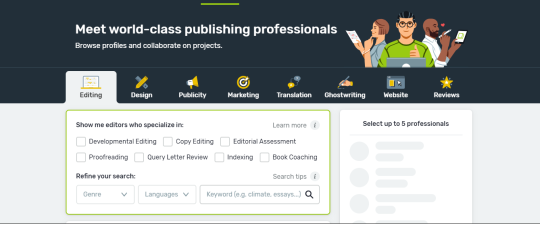
Feel free to give your book/WIP (Work in progress) a title. Remember, it's okay if it's not your final title, as you can always change it in the settings of your book later.
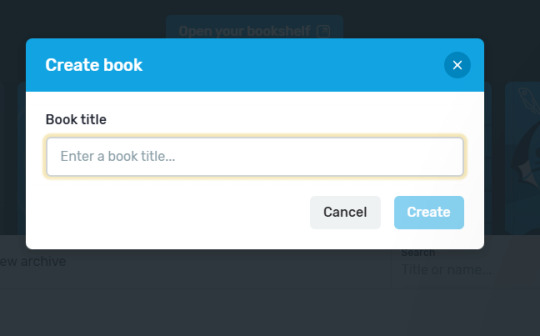
Once you've created it, you can take your time and when you're ready, you can click "Write.”
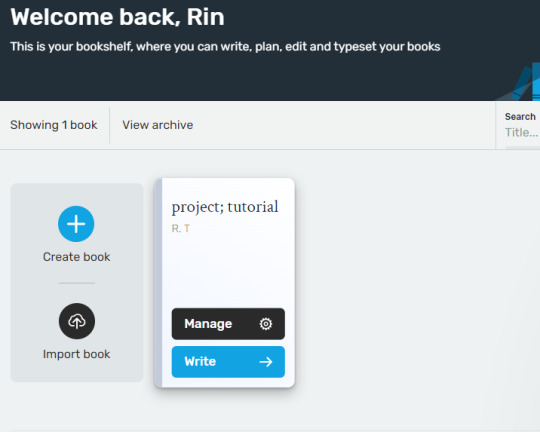
Once you click "Write," you'll be directed to the next page. There, you'll find your chapters, the space to write your manuscript, and a sidebar with various helpful features provided by Reedsy.
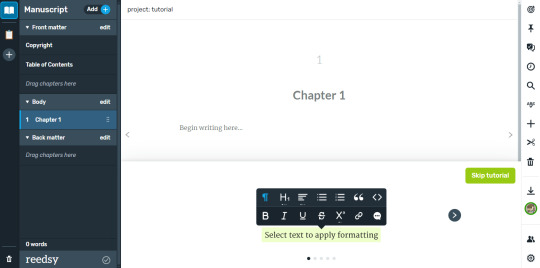
Then, you can choose any name for your chapter that feels meaningful to you.
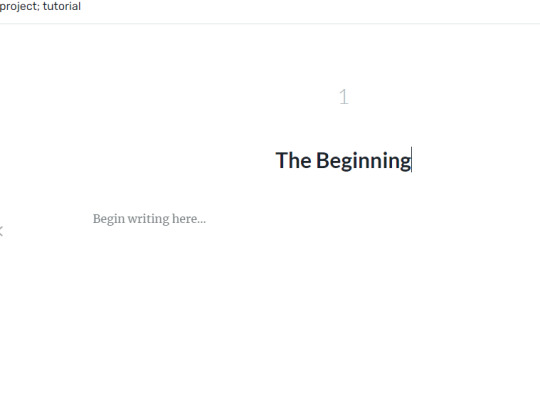
You can also track your writing goals for your specific manuscript or book. This feature provides insights into your writing habits, such as the days you've written and the number of words you've written. You can also set a target word count goal for the manuscript, and you also have the option to set manual writing goals. Additionally, you can check the word count in your current chapter from the bottom of the widget.
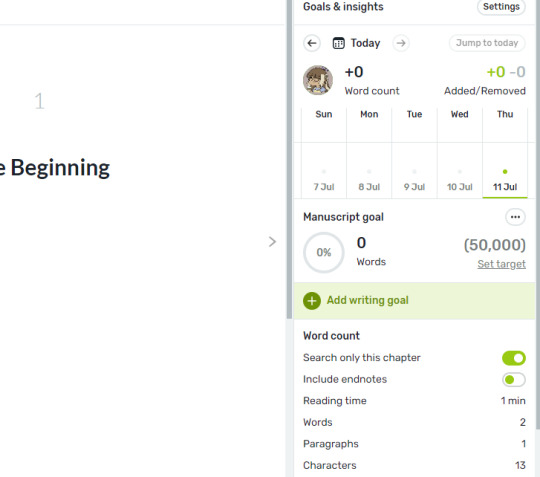
You have the option to set a deadline and choose the days that work best for you to write. This will help Reedsy estimate a realistic word count goal for you.
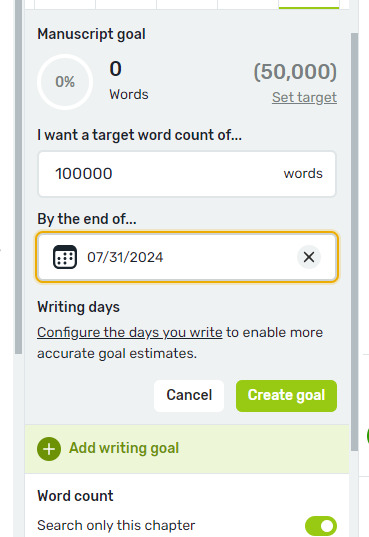
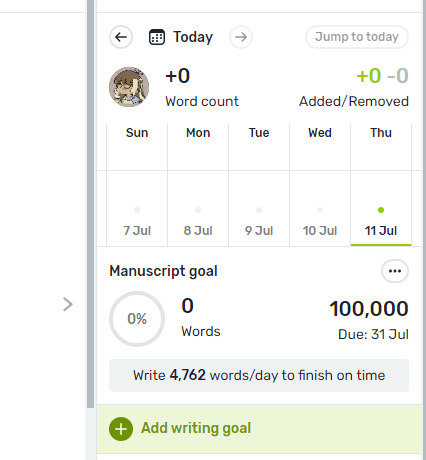
Remember that on Reedsy, there's a new beta feature that allows you to plan and outline your novel without having to leave the website. It offers note cards for you to jot down the plot and scenes from your novel, which can serve as a helpful guide and provide a simple outline to support your writing process.
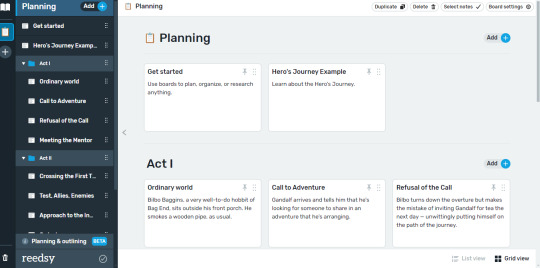
Also, don’t forget the various features available to you when creating your book in Reedsy. For instance, you have the option to include preset formatted pages such as a dedication page and an epigraph that resonates with your story. These features can add a lot of value to your book, and I encourage you to explore them further.
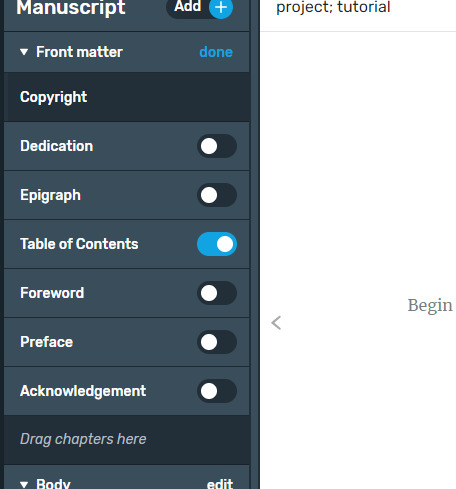
Hopefully this can help you understand the basics of Reedsy Book Editor. One of my favorite writing softwares that is completely FREE!
Hey fellow writers! I'm super excited to share that I've launched a Tumblr community. I'm inviting all of you to join my community. All you have to do is fill out this Google form, and I'll personally send you an invitation to join the Write Right Society on Tumblr! Can't wait to see your posts!
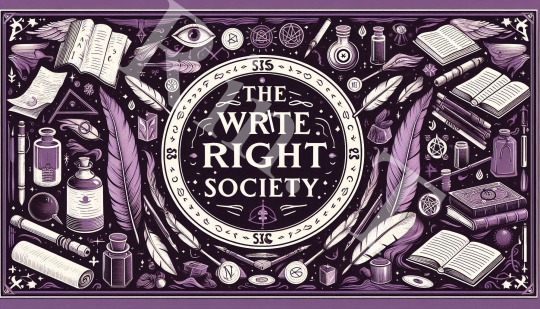
#writeblr#creative writing#thewriteadviceforwriters#writers on tumblr#writer things#writing#writing tips#on writing#writer#writer community#writing tools#writing resources#writing blog#writing advice#fiction writing#novel writing#author#book writing#publishing#indie author#fiction#reedsy#book editor#bookblr#self concept#bookworm#bookstore#books and reading#reading#book quotes
184 notes
·
View notes